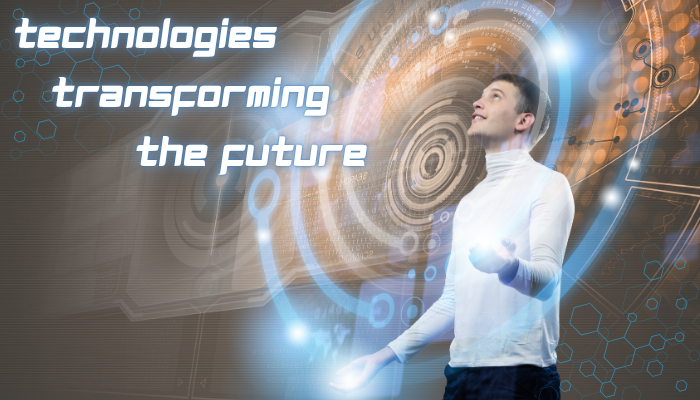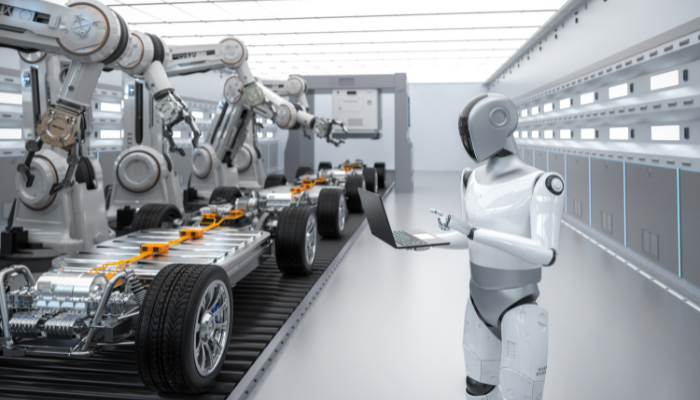The future is unfolding at a pace that’s both exhilarating and challenging for business leaders. Emerging technologies like artificial intelligence, blockchain, and autonomous systems aren’t just shaping the next wave of innovation; they’re already driving decisions, efficiency, and growth for organizations across the globe. In a time when being flexible is key, adopting these tools can determine whether you’re at the forefront or falling behind.
For businesses striving to remain competitive, understanding how these technologies will reshape industries is critical. In this blog, we’ll explore the top 10 technologies that are not just on the horizon but actively transforming sectors like healthcare, finance, and manufacturing today.
Let’s look at how these technologies are changing the world as we know it.
The Impact of Technology in Shaping Tomorrow’s World
As we move into the future, the influence of technology is becoming even more pronounced. AI, blockchain and 5g are at the forefront of shaping tomorrow’s business world. AI is helping businesses make smarter, faster decisions, 5G is enabling quicker communication and more efficient operations, and blockchain is making transactions more secure and transparent.
These technologies are creating new ways for businesses to grow, innovate, and build trust in a fast-changing world.
Also Read: Key Areas of Technology: Definitions and Practical Examples
Why Understanding Emerging Technologies is Crucial
As businesses grow and industries evolve, the demand for technological innovation continues to rise. Emerging technologies can help businesses solve long-standing challenges, create new opportunities, and streamline day-to-day operations.
- Staying Competitive: By adopting new technologies, businesses can be ahead of competitors who may be slower to adapt.
- Opening New Markets: Emerging technologies can unlock entirely new markets and revenue streams for businesses.
- Improving Product & Service Delivery: From faster product development cycles to better quality assurance, technology can enhance your offerings.
- Adapting to Consumer Behavior: With technological tools, businesses can respond fast to shifts in consumer preferences and demands.
By understanding the technologies that are making an impact today, you can better prepare for the future. Entrepreneurs need to stay updated with the latest technology to remain competitive and succeed.
Now that we’ve set the stage, let’s jump into the first of these groundbreaking technologies that are shaping the future.
Top 10 Best Technologies Transforming the Future
Innovation is crucial for businesses aiming to grow and thrive. Emerging technologies are transforming operations, boosting efficiency, and opening up new growth opportunities.
This section highlights the top 10 technologies that are not just changing industries but are driving progress and success.
1. Artificial Intelligence & Machine Learning
AI and Machine Learning (ML) are not just trends; they are essential tools for business leaders. These technologies help companies make better decisions, work more efficiently, and tackle challenging problems. By enabling machines to analyze data, predict outcomes, and carry out tasks typically done by humans, AI and ML allow businesses to simplify operations, reduce costs, and stay ahead in a data-focused world.
Core Features:
- Automation: AI can automate routine tasks, such as sorting through customer inquiries or analyzing large datasets, freeing up time for higher-level decision-making.
- Predictive Analytics: ML uses past data to predict trends, helping businesses forecast customer behavior, manage inventory, and reduce risks.
- Natural Language Processing (NLP): NLP allows machines to understand and interact with human language, allowing businesses to enhance customer service with AI-driven chatbots and voice assistants.
- Personalization: AI-driven systems use customer data to offer personalized experiences, whether through product recommendations or tailored content.
Specific Challenges AI & ML Solve:
- Better Decision-Making: AI can process large amounts of data and spot patterns that may be overlooked by humans, leading to quicker and more precise decisions. For instance, banks use AI to identify fraudulent transactions by recognizing unusual spending behaviors as they happen.
- Customer Personalization: Machine learning algorithms examine past customer behavior to predict the products they are most likely to purchase. This allows businesses, especially in retail, to provide tailored recommendations, boosting customer satisfaction and driving sales.
- Operational Efficiency: AI automates repetitive tasks like processing invoices and managing inventory, freeing up employees to focus on more important work.
- Risk Mitigation: In manufacturing, AI helps predict equipment failure before it happens, reducing downtime and maintenance costs. Similarly, ML helps in identifying potential risks in financial markets, enabling better portfolio management.
And the AI market is expected to hit US$244.22bn by 2025, showing just how important it is to get on board now.
2. Blockchain: Redefining Trust and Transparency
Blockchain is not just the backbone of cryptocurrencies; it’s a powerful tool reshaping industries by enabling secure, transparent, and decentralized transactions. As businesses increasingly rely on data, blockchain’s ability to ensure data integrity and provide verifiable records is a game-changer. For decision-makers, adopting blockchain technology means enhancing security, reducing fraud, and increasing efficiency in operations.
Core Features:
- Decentralization: Blockchain runs on a network of computers, meaning no single authority controls it. This ensures security and transparency, lowering the chances of fraud.
- Immutability: Once a transaction is added to the blockchain, it cannot be changed, making it perfect for keeping secure and transparent records.
- Smart Contracts: These self-executing contracts are part of the blockchain and automatically perform actions when set conditions are met, cutting administrative costs and reducing human error.
- Security: Blockchain’s encryption makes transactions highly secure, protecting sensitive information from breaches and fraud.
Specific Challenges Blockchain Solves:
- Reducing Fraud: Blockchain’s transparency and immutability ensure that every transaction is visible and tamper-proof, significantly reducing the risk of fraud. For example, in banking, blockchain prevents unauthorized transactions and ensures that digital payments are secure.
- Supply Chain Transparency: Blockchain provides end-to-end visibility of products as they move through the supply chain. This guarantees product authenticity, prevents fraud, and ensures that goods are ethically sourced. For example, Walmart uses blockchain to trace food products from farm to shelf, enhancing food safety and cutting down on waste.
- Faster and Cheaper Transactions: Blockchain removes intermediaries, speeding up transactions and lowering costs. Cross-border payments are a prime example where blockchain speeds up transfers and eliminates costly middlemen such as banks or money transfer services.
- Data Integrity: In healthcare, patient records stored on a blockchain are tamper-proof, ensuring that only authorized professionals can access and update information. This eliminates data breaches and enhances patient privacy.
- Automating Processes: Smart contracts execute agreements automatically when conditions are met, minimizing delays and human error in sectors like real estate.
Blockchain provides key benefits by enhancing security, transparency, and efficiency across multiple industries.
Also Read: How Blockchain Technology Works in Healthcare Sector
3. Extended Reality (XR): Revolutionizing Interaction with the World
Extended Reality (XR), encompassing Virtual Reality (VR), Augmented Reality (AR), and Mixed Reality (MR), is reshaping how businesses connect with customers, employees, and partners.
By blending the digital and physical worlds, XR creates immersive experiences that offer new ways to train, market, and interact. For business leaders, XR provides the opportunity to stand out in competitive markets by offering more engaging, innovative experiences.
Core Features:
- Immersive Experiences: XR allows users to experience environments or products in a fully immersive way, enhancing interaction and engagement.
- Real-Time Interaction: With XR, businesses can create interactive experiences that respond to user input in real time, enhancing learning, training, and customer service.
- Remote Collaboration: XR enables teams to collaborate in virtual environments, regardless of physical location, making remote work more effective.
- Personalization: XR can be used to tailor experiences to individual users by providing context-sensitive interactions based on user preferences or behaviors.
Specific Challenges XR Solves:
- Training and Education: XR provides realistic training environments, which can be especially useful in high-risk industries. For example, healthcare professionals can practice surgeries or procedures in a safe, virtual setting, reducing the risk of mistakes and improving learning outcomes.
- Customer Engagement: In retail, augmented reality enables customers to virtually try on clothes or visualize how furniture would look in their homes, helping them make more informed purchasing decisions and enhancing customer satisfaction.
- Remote Work and Collaboration: XR technologies like MR enable teams to collaborate in shared virtual environments, breaking down geographical barriers. This helps engineering teams or product designers to create and test prototypes in real-time, regardless of where they’re located.
- Product Design and Prototyping: Using XR, businesses can visualize and test products before committing to physical prototypes. This is particularly useful in industries like manufacturing and automotive, where early-stage testing can save significant time and resources.
- Marketing and Advertising: XR offers businesses the chance to create memorable marketing experiences that engage consumers on a deeper level. For example, car manufacturers use VR to offer virtual test drives, allowing customers to experience their vehicles before making a purchase.
XR is making a significant impact in industries by enhancing engagement, improving training, and creating innovative customer experiences. For business leaders, adopting XR can unlock new possibilities in how products are designed, marketed, and experienced, giving your business a competitive edge.
4. 5G Technology: Accelerating Connectivity and Innovation
5G is not just about faster internet speeds; it’s a revolutionary leap in mobile network technology that enables real-time, high-volume, low-latency communication across devices. With its ability to support a massive number of devices simultaneously, 5G is laying the foundation for smarter cities, advanced robotics, and next-gen technologies.
Core Features:
- High-Speed Connectivity: 5G provides data speeds up to 100 times faster than 4G, making real-time data transfer seamless.
- Low Latency: With reduced delay, 5G allows businesses to make real-time decisions without lag, which is critical for applications like autonomous vehicles or remote surgeries.
- Increased Device Capacity: 5G can support up to a million devices per square kilometer, enabling the growth of the Internet of Things (IoT) and smart device ecosystems.
- Improved Network Reliability: 5G provides ultra-reliable, high-performance connectivity, ensuring that critical applications have consistent and uninterrupted service.
Specific Challenges 5G Solves:
- Remote Operations and Automation: 5G enables the connection of large numbers of devices with near-zero latency, which is essential for manufacturing environments that rely on automated machines and robots. Real-time machine-to-machine communication reduces downtime and improves production efficiency.
- Enhanced Healthcare Services: With 5G, telemedicine can be taken to the next level by enabling high-definition video consultations with virtually no lag. It also supports remote surgeries, where doctors can operate robotic instruments in real-time, regardless of physical location.
- Smarter Transportation: 5G allows autonomous vehicles to communicate with each other and the surrounding infrastructure, improving both safety and coordination in transportation. For example, self-driving cars can exchange data about road conditions, traffic, and nearby vehicles, making real-time decisions more effective.
- Seamless Streaming and Entertainment: The entertainment sector can take advantage of 5G’s high bandwidth to stream ultra-high-definition content instantly, even in remote areas. For instance, live sports events can be broadcast in 4K or 8K, providing viewers with an enhanced experience and minimal buffering.
- Better Connectivity in Smart Cities: 5G is key to the widespread adoption of smart city technologies. It enables cities to deploy connected devices that monitor traffic, manage public services, and optimize energy use. This allows for real-time traffic management and smarter energy distribution.
For business leaders, integrating 5G into operations and customer services can lead to greater efficiency, improved safety, and the opportunity to explore innovative business models.
5. Internet of Things (IoT): Connecting Devices, Improving Efficiency
The Internet of Things (IoT) connects everyday devices to the internet, allowing them to share and act on data. This ability to monitor, control, and optimize devices remotely is driving innovations across industries. For business leaders, IoT provides the tools needed to simplify operations, reduce costs, and enhance customer experiences by leveraging real-time data.
Core Features:
- Real-Time Monitoring: IoT allows businesses to collect and analyze data from connected devices in real-time, enabling better decision-making and proactive actions.
- Automation: IoT enables the automation of tasks, reducing human intervention and increasing operational efficiency. For instance, smart thermostats and lighting systems automatically adjust based on usage patterns.
- Predictive Analytics: With IoT sensors collecting data, businesses can predict issues before they arise, allowing for preventative maintenance or smarter inventory management.
- Interconnected Devices: IoT facilitates seamless communication between various devices, enabling smart ecosystems where all parts work together for optimal performance.
Specific Challenges IoT Solves:
- Inventory Management: In retail, IoT tracks product levels in real-time, allowing businesses to optimize stock levels and reduce out-of-stock situations. This helps improve sales and customer satisfaction by ensuring popular items are always available.
- Predictive Maintenance: In manufacturing, IoT sensors monitor equipment health, sending alerts before machines fail. This proactive approach reduces unplanned downtime, extending equipment lifespan and saving maintenance costs.
- Customer Experience: In healthcare, IoT-connected devices such as wearables track patient vital signs in real-time, enabling doctors to monitor their condition remotely and make faster, more informed decisions.
- Energy Efficiency: In commercial buildings, IoT-based energy management systems monitor energy consumption, adjust lighting and heating based on occupancy, and reduce waste, leading to significant cost savings.
- Supply Chain Optimization: In logistics, IoT sensors track the movement and condition of goods in real-time, helping companies optimize delivery routes, ensure product quality, and improve customer satisfaction by offering precise delivery times.
IoT is transforming industries by offering smarter ways to monitor, control, and optimize operations. As businesses continue to adopt IoT technologies, they can unlock significant efficiencies, improve customer experiences, and make data-driven decisions that drive growth.
Also Read: Emerging IoT Trends and Technologies to Watch in 2025
6. Virtual Reality 2.0: Creating Immersive, Interactive Experiences
Virtual Reality (VR) 2.0 has taken immersive experiences to the next level, offering hyper-realistic simulations that are revolutionizing industries like education, healthcare, retail, and real estate. This technology enables businesses to create fully interactive environments, allowing for enhanced customer experiences, employee training, and product design.
Core Features:
- Immersive Interaction: VR creates fully immersive experiences by placing users in a virtual world where they can interact with objects and environments as if they were real.
- Real-Time Feedback: VR systems offer real-time interaction, allowing businesses to respond to user actions instantly and create more engaging environments.
- Simulation: VR allows businesses to simulate real-world scenarios for training, testing, and experimentation without any real-world risk.
- 3D Visualization: VR enables users to explore and manipulate three-dimensional models, helping them visualize complex concepts or products in a more intuitive way.
Specific Challenges VR Solves:
- Employee Training: VR provides a safe environment for employees to practice complex or hazardous tasks without the risks associated with real-world training. For example, medical professionals can use VR to practice surgeries before performing them on patients.
- Product Testing and Design: In manufacturing, VR allows designers and engineers to visualize products in 3D, testing and modifying designs before production. This helps reduce costly errors and improves the final product.
- Customer Engagement: Retail businesses use VR to create immersive shopping experiences. For instance, customers can virtually try on clothes or experience products in 3D before making a purchase decision.
- Remote Consultations: In healthcare, VR enables doctors to conduct remote consultations, offering patients a virtual visit when in-person appointments aren’t possible.
- Real Estate: VR allows prospective buyers to explore properties remotely, experiencing the space virtually before physically visiting, saving time and expanding their options.
VR is increasingly being used to enhance customer engagement, improve training and product testing, and offer unique services. As businesses adopt VR technology, they can provide more interactive and efficient experiences for both employees and customers.
Also Read: AI/VR Development: How AI is Transforming Virtual Gaming
7. Generative AI: Unlocking Creativity and Innovation
Generative AI goes beyond traditional machine learning by creating entirely new content, whether it’s text, images, music, or even code. This technology is transforming industries by automating creative tasks, generating novel ideas, and pushing the boundaries of what’s possible in art, design, and product development.
Core Features:
- Content Creation: Generative AI can produce original content, such as articles, social media posts, and product descriptions, based on input data or user prompts.
- Personalization: Generative AI tailors content to the needs and preferences of individual users, enhancing customer engagement and satisfaction.
- Problem Solving: AI models generate new ideas or solutions, assisting in product design, marketing strategies, or even new business models.
- Automation: Automates repetitive tasks in creative fields, such as designing graphics or writing copy, freeing up human resources for higher-level work.
- Data-Driven Creativity: Generative AI leverages existing data and trends to create innovative products, ideas, or designs that are aligned with consumer preferences.
Specific Challenges Generative AI Solves:
- Scaling Content Creation: In marketing, generative AI can automate the creation of written content, social media posts, and email campaigns, reducing the time and effort needed to produce high-quality content at scale.
- Product Design: In fashion, generative AI uses past designs and trends to create new, innovative clothing styles that meet customer demand. This accelerates the design process and ensures products are aligned with market preferences.
- Personalized Recommendations: Retailers use generative AI to recommend products to customers based on their past shopping behavior, providing a personalized shopping experience and increasing conversion rates.
- Creative Industries: In music, art, and film, generative AI can compose music, create artwork, and even generate scripts. This speeds up the creative process and provides fresh, innovative content ideas for producers and content creators.
- Product Customization: Manufacturers can use generative AI to develop custom products based on individual customer preferences. For instance, Nike has used AI to offer custom-designed shoes based on a customer’s specific needs.
Business leaders can harness this technology to scale operations, generate fresh ideas, and maintain a competitive edge in a rapidly evolving market.
Not sure which tech trends actually matter for your business? Let’s cut through the noise together.
→ Get a Complimentary Tech Strategy Session
8. Biotechnology: Revolutionizing Health and Sustainability
Biotechnology combines biology with technology to develop solutions that address some of the world’s most pressing challenges. From creating new treatments in healthcare to developing sustainable farming methods and eco-friendly alternatives, biotechnology is making significant strides in improving human health and preserving the environment.
Core Features:
- Gene Editing: Biotechnology enables the modification of DNA to correct genetic disorders, improve crops, and create more efficient biofuels.
- Personalized Medicine: By analyzing genetic information, biotechnology allows for the development of custom treatments that target the specific needs of individuals.
- Sustainable Production: Biotech solutions improve the efficiency of manufacturing processes, using natural resources to produce sustainable products.
- Bio-based Materials: The development of biodegradable materials, biofuels, and plant-based alternatives helps reduce the environmental impact of traditional manufacturing and energy production.
- Biological Research: Biotechnology advances scientific research to improve drug development, create vaccines, and understand complex biological systems.
Specific Challenges Biotechnology Solves:
- Health and Disease Management: Personalized medicine tailored to an individual’s genetic makeup is revolutionizing how diseases are treated, improving treatment effectiveness and reducing side effects. For example, CRISPR technology is being used to treat genetic diseases like sickle cell anemia.
- Sustainability in Agriculture: Biotechnology helps produce genetically modified crops that are more resistant to pests, diseases, and environmental changes, increasing crop yields and reducing the need for pesticides. This is crucial for feeding a growing global population with fewer resources.
- Climate Change Mitigation: Biotech solutions like biofuels provide renewable energy alternatives, reducing dependence on fossil fuels and cutting carbon emissions. Biotech also creates biodegradable plastics that help reduce waste in the environment.
- Food Security: Biotechnology addresses food scarcity by improving the nutritional content and shelf life of crops. It enables the creation of more resilient food sources that are adaptable to various environmental conditions.
- Waste Management: Biotech offers innovative solutions for waste treatment and recycling, such as using microorganisms to break down pollutants and reduce industrial waste.
For business leaders, embracing biotech innovations can drive new product development, improve operational efficiency, and help meet sustainability goals while addressing some of the world’s most critical needs.
9. Quantum Computing: The Next Frontier in Problem Solving
Quantum computing represents a breakthrough in computing technology that harnesses the principles of quantum mechanics to solve complex problems at speeds and scales that traditional computers cannot achieve.
While still in its early stages, quantum computing has the potential to revolutionize industries by solving problems that are currently intractable for classical computers, such as optimizing complex systems, modeling molecular interactions, and accelerating machine learning.
Core Features:
- Superposition: Quantum computers use qubits, which can exist in multiple states simultaneously, allowing them to process vast amounts of information in parallel.
- Entanglement: Qubits can be entangled, meaning the state of one qubit is linked to another, even if they are separated by large distances. This enables faster data transmission and more efficient problem-solving.
- Quantum Speedup: Quantum algorithms can solve specific problems much faster than classical algorithms, exponentially increasing computing power for tasks like optimization and cryptography.
- Parallel Processing: Unlike classical computers that process information sequentially, quantum computers perform calculations in parallel, dramatically reducing the time required to solve complex problems.
- Quantum Algorithms: Quantum algorithms like Shor’s algorithm (for factoring large numbers) and Grover’s algorithm (for searching unsorted databases) offer exponential improvements in computation efficiency for specific tasks.
Specific Challenges Quantum Computing Solves:
- Complex Problem Solving: Quantum computers are capable of solving optimization problems that would take traditional computers millions of years. For example, supply chain optimization can be accelerated by quantum algorithms, allowing businesses to find the most efficient routes, reduce costs, and improve delivery times.
- Drug Discovery: In pharmaceuticals, quantum computing could enable faster simulations of molecular interactions, drastically speeding up drug discovery and reducing the time it takes to bring life-saving treatments to market.
- Material Science: Quantum simulations can model complex materials and chemical reactions, helping industries like electronics, aerospace, and energy discover new materials with unique properties that are impossible to simulate with classical computers.
- Cryptography: Quantum computing poses both a challenge and an opportunity for data security. It has the potential to break current encryption methods but also offers the ability to create much stronger encryption techniques using quantum-resistant algorithms.
- Machine Learning: Quantum computing can accelerate the training of machine learning models, enabling more accurate predictions and faster processing of large datasets, making it particularly useful for industries relying on big data.
While quantum computing is still emerging and not yet fully realized for widespread use, its potential to solve complex problems faster and more efficiently is transformative.
For business leaders, investing in quantum computing research or preparing for its adoption can provide a significant competitive edge in industries ranging from healthcare to finance to manufacturing.
10. Edge Computing: Enabling Real-Time Data Processing
Edge computing is a distributed computing framework that processes data closer to where it is generated, rather than relying on centralized cloud servers. By decentralizing computation and moving it closer to the data source, edge computing reduces latency, enhances speed, and enables real-time decision-making.
Core Features:
- Low Latency: Edge computing processes data locally, reducing the time it takes to send information to a distant cloud server and back. This is critical for applications requiring real-time responses.
- Decentralized Processing: Data is processed on devices or local servers at the edge of the network, such as on smartphones, sensors, or routers, reducing reliance on centralized cloud infrastructure.
- Bandwidth Efficiency: By processing data locally, only necessary information is sent to the cloud, conserving bandwidth and reducing operational costs.
- Scalability: Edge computing enables businesses to scale their IoT systems without the need for significant upgrades to centralized data centers.
- Enhanced Security: With sensitive data processed locally, edge computing reduces the risk of exposure during transmission, offering a more secure method for handling confidential information.
Specific Challenges Edge Computing Solves:
- Real-Time Decision-Making: In industries like manufacturing, edge computing processes data from machines and sensors in real-time, enabling immediate actions such as stopping a malfunctioning machine or adjusting production lines to avoid errors.
- IoT Efficiency: For retailers, edge computing enables real-time data processing from IoT devices, such as smart shelves or inventory management systems, providing up-to-the-minute stock information and enabling quicker restocking decisions.
- Remote Operations: Energy companies in remote locations use edge computing to process data locally, such as monitoring energy production or detecting issues with offshore rigs, reducing dependence on centralized systems and minimizing downtime.
- Smart Cities: Traffic management systems in smart cities use edge computing to process traffic data locally, optimizing traffic lights and flow patterns in real-time, reducing congestion, and improving urban mobility.
- Healthcare: In healthcare, edge computing powers remote patient monitoring and real-time medical data analysis. Wearable devices process health data on-site and send critical information to doctors instantly, allowing for faster treatment.
Edge computing is crucial for industries where speed, efficiency, and security are paramount. By processing data at the edge of the network, businesses can make faster, more informed decisions, reduce costs, and scale operations effectively without relying on centralized cloud systems.
Also Read: Key AI Trends to Watch in 2025
Ready to Embrace the Future? Let’s See How You Stack Up!
The future is knocking, and these technologies are more than just buzzwords, they’re changing how businesses operate and thrive. But how prepared is your business to step into this new world? Let’s see where you stand.
1. Is your business using AI to make smarter decisions or automate tasks?
- If not, you might be missing out on a major opportunity. AI can optimize your processes and help you make quicker, data-driven decisions.
2. Have you considered blockchain to enhance security or streamline payments?
- If you haven’t, now might be the perfect time. Blockchain offers transparency, security, and faster transactions, especially in finance and supply chain.
3. What about IoT? Are you tracking data in real-time and improving efficiency with connected devices?
- If not, you’re probably leaving data-driven insights on the table. IoT helps you keep everything running smoothly with smart devices that communicate seamlessly.
4. Is your team ready to innovate with VR/AR for training or customer engagement?
- If not, you might be falling behind. Virtual and augmented reality can help you train employees or offer customers unforgettable experiences.
5. Are you ready to leverage Generative AI to boost creativity and speed up content creation?
- If not, you’re missing a huge creative boost. Generative AI can help you create personalized content and innovative solutions at scale.
If any of these questions made you think, “Hmm, maybe it’s time to upgrade,” then Codewave is here to help. We specialize in helping businesses like yours integrate these Next-Gen technologies and create solutions that drive results. Whether you’re starting small or ready to go all-in on digital transformation, we’ve got the expertise to guide you through it.
Why Choose Codewave?
Codewave Wins 50Pros Award for Excellence in Agency Leadership – 2025
This award reflects our dedication to delivering innovative, results-driven solutions.
Here’s how we help businesses succeed using the latest technologies:
- AI & Machine Learning: We leverage AI & ML to automate processes, improve decision-making, and create personalized experiences, helping businesses across industries enhance efficiency and drive growth.
- Blockchain: Our blockchain solutions improve security, transparency, and traceability in transactions and supply chains, enabling businesses to operate more securely and efficiently.
- Extended Reality (XR): We create immersive AR/VR experiences that enhance customer engagement, improve training, and transform the way businesses interact with users.
- Generative AI: We use generative AI to automate content creation, design new products, and accelerate innovation, helping businesses stay ahead in a fast-paced market.
Explore our Portfolio to see the real-world impact of our work,
Ready to take the leap? Let’s talk and see how we can help you turn these future technologies into real-world success.
Codewave is a UX first design thinking & digital transformation services company, designing & engineering innovative mobile apps, cloud, & edge solutions.







